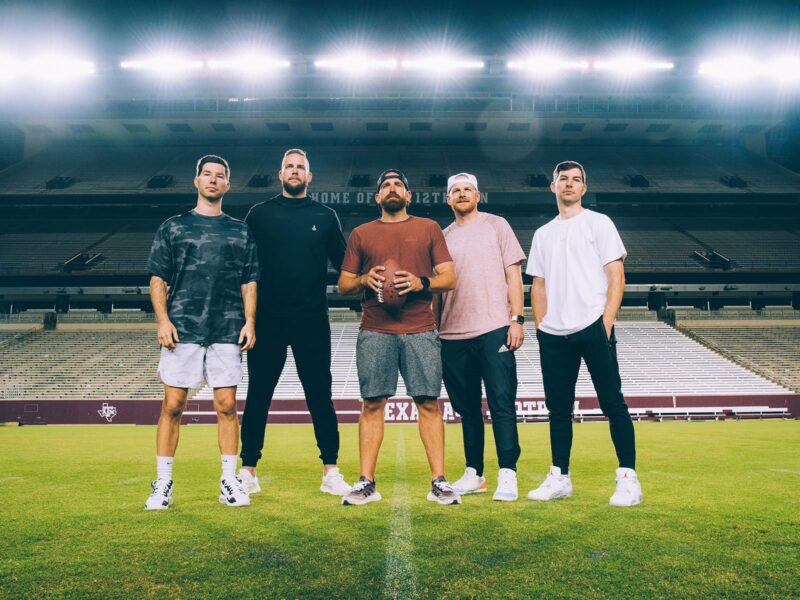Texas A&M Begins Yearlong Celebration For 12th Man Centennial
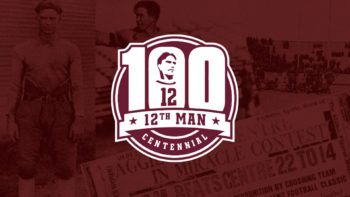
It was Jan. 2, 1922 at Dallas’ Fair Park Stadium when Earl King Gill ’24, a basketball player and former football team member for Texas A&M University, took his place in school history as the original 12th Man.
Texas A&M is celebrating The 12th Man Centennial with presentations at athletics events, a documentary, campus events, special-edition collectibles and merchandise, and more throughout the 2021-22 academic year.

A Simple Act Becomes Legendary
As the legend goes, the Aggies were outgunned by the undefeated Praying Colonels from Centre College in the Dixie Classic which took place in a 12,000-capacity stadium near where the Cotton Bowl in Dallas is today.
It wasn’t looking good for the Aggies, whose reserve players were dwindling as injuries mounted. Gill was in the press box helping reporters identify players on the field when Texas A&M Head Coach Dana X. Bible signaled him to come to the sideline and suit up.
Gill, who entered the university in 1920 to study mechanical engineering, had earned letters in football, baseball and basketball, and hadn’t expected to play in the Dixie Classic. He’d been home in Dallas to spend Christmas with his family, so when Bible called him down, he had to put on an injured player’s uniform, quickly changing under the bleachers. He remained on the sideline, ready to play, for the rest of the game, which the Aggies managed to turn into a stunning upset, winning 22-14.
Although he never actually played that day, Gill’s willingness to step up for the team became emblematic of the university’s core values, uniting the student body which today is known collectively as “The 12th Man.”
The tradition lives just as much off the field as on, as the spirit of the 12th Man is exemplified by Aggies in countless ways, from service projects to emergency relief operations, said Texas A&M University President M. Katherine Banks.
“It’s been amazing to see how the 12th Man tradition has endured over the last century,” Banks said. “This tradition has bound generations of Aggies from all over the world together with an unwavering commitment to serve others, just as E. King Gill stood ready to serve his team.”

The Years That Followed
Gill graduated from Texas A&M in 1924, spent a year coaching football in Greenville, Texas, and subsequently enrolled at the Baylor School of Medicine, where he earned his medical degree in 1929. He served as an Air Force colonel during World War II, returned to Texas and began a 40-year career as an eye, ear, nose and throat specialist in Corpus Christi. He died in Rockport, Texas in 1976 at the age of 74.
Even though Gill’s famous act occurred in 1922, it wasn’t until the 1939 national championship season that the 12tth Man tradition really caught on.
E.E. McQuillen ’20 was executive secretary of The Association of Former Students (1926-47). During the ’39 football season, he was asked to prepare an anecdote about the team that could be told on radio. The story he chose was Gill’s, and ever since that season, the Texas A&M student body stands for the entirety of all home football games.
In 1964, Gill spoke at campus Muster, the audio of which was unearthed in 2019 in the possession of a class of ’64 Aggie. He was introduced at Muster by Texas A&M President Gen. James Earl Rudder ’32, who spoke of the day Gill stood ready to play.
“As he came forward, ready to play football in 1922 and later to serve this country in war, he is an example of the kind of spirit which has inspired Aggies everywhere in times of war and peace,” Rudder said. “He is the 12th Man to which we all aspire.”
When Gill addressed the Muster audience, he described the event that brought him fame and its effect on his life in the years to come.
“On the lighter side, it’s made me the prime recipient of all the A&M jokes that came along,” Gill said. “But I’ve never thought that the 12th Man really belongs to a personality, it belongs to the A&M student body. Every one of you can be a 12th Man if you stand up for what’s right and be ready to serve.”
Retired Texas A&M University archivist David Chapman ’67, who served as director of the Cushing Memorial Library & Archives, spent much of his 38-year career with the university as an historian researching and documenting Aggie history.
Chapman recalled his days as a Texas A&M student in the 1960s, saying the 12th Man was the same unifying tradition then as it is today.
“There was a feeling of camaraderie and it was us against the world, so to speak,” he said, adding that he met Gill once at the Corpus Christi Country Club and that “he was quite a character.”
In 1995, Chapman authored an article about Gill for Texas Aggie magazine in which he wrote, “No more visible tradition exists at Texas A&M than that of the 12th Man. It’s more than students standing throughout athletic contests to demonstrate their willingness to serve if needed. It is the very embodiment of the Aggie Spirit and loyalty to Texas A&M.”

The Tradition Grows
In the decades that followed the famous game, Texas A&M students and supporters have found many more ways to express the spirit of the 12th Man.
In 1941, College Station resident Lil Munnerlyn wrote a song called “The Twelfth Man” that was debuted at a Yell Practice and today is sung only after the Aggies have been outscored, its lyrics known to lift sagging spirits:
Texas Aggies down in Aggieland,
We’ve got Aggie Spirit to a man.
“Stand united!” That’s the Aggie theme,
We’re the 12th Man on the team.
When we’re down, the goin’s rough and tough,
We just grin and yell: “We’ve got the stuff
To fight together for the Aggie dream.”
We’re the 12th Man on that fightin’ Aggie team!
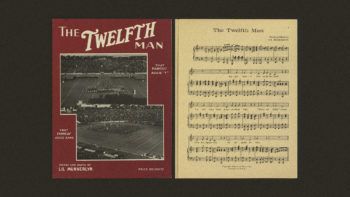
In 1950, the 12th Man Foundation was formed to support scholarships, programs and facilities to benefit Texas A&M athletes. The 12th Man Foundation is one of Texas A&M’s three funding affiliates, the others being The Association and the Texas A&M Foundation.
Tyson Voelkel ’96, president and CEO of the Texas A&M Foundation, said he’d heard the Gill legend when he was growing up in Brenham, Texas, but that it didn’t really resonate until he’d lived long enough to appreciate its wisdom.
“I look back on all the times I was given a choice to either disengage and protect myself or put myself out there for those I cared about,” said Voelkel, who served 12 years as a U.S. Army infantry officer. “Every moment I chose to ‘suit up’ in the face of adversity or uncertainty is a moment I’m genuinely proud of, regardless of the outcome. To me, the 12th Man tradition speaks to the very core of who Aggies are. We show up.”

The class of 1980 showed up when they gifted the university its first 12th Man statue, a life-size, bronze statue of Gill dressed in a football uniform. The statue stood at the north entrance of Kyle Field up until 2014, when it was moved to Rudder Plaza.
With the redesign of the stadium came a new, bigger-than-life statue of Gill which stands in Kyle Field Plaza.
In 1985, the now-ubiquitous 12th Man towel was created by students in the 12th Man Student Aggie Club. Ever since, scores of Aggie fans at Kyle Field wave the towels as a show of support for the team and variations of the original design are prized collectibles.

It was three years later that the words “Home Of The 12th Man” were placed in huge letters on the student section of Kyle Field, a gift from the class of 1988. When the stadium was redesigned, new letters were installed. The original letters were preserved and later auctioned off to support the Memorial Student Center.
In 1990, the university made its relationship with the 12th Man official by trademarking the term. University officials have fought to keep the popular term for Aggies alone, addressing nearly 600 trademark infringements.
Soon after the 21st century began, the student body grabbed the nation’s attention, being named the best student section in college football in 2006 by ESPN and the No 1. gameday experience by Sports Illustrated in 2011.
Texas A&M Student Body President Natalie Parks ’22, a communication major from Denton, Texas, said that since last year when the pandemic canceled spring sports and limited attendance at football games, she is especially thrilled to return to campus and see the 12th Man spirit back in full force.
“I am so proud and excited to be able to stand with the 12th Man as we return to a full Kyle Field and Reed Arena this year,” she said. “This tradition brings us together both physically and symbolically, inside and outside of athletics. The concept of the 12th Man is motivating and unifying, and serves as a reminder that together we can overcome all obstacles.”
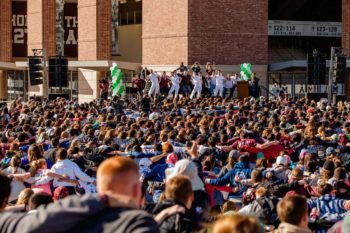
Beyond Sports
The 12th Man spirit of unity, loyalty and selfless service has extended far beyond Kyle Field, Reed Arena, Olsen Field at Blue Bell Park and other sports facilities on campus. It is spread throughout the Bryan-College Station community, stretches across the state of Texas and is amplified around the nation in myriad ways.
“I think of service-based projects such as the Big Event, which works to serve thousands of people in the Bryan-College Station area and has since become a program that has spread to multiple universities across the country,” said Parks. The Big Event is the largest, one day student-run service project in the nation, where thousands of Aggies work to beautify the local community.
In 2013, hundreds of students planted thousands of tree seedlings in Bastrop State Park after the most destructive wildfire in Texas history tore through the area. The student organization Aggie Replant led the effort along with the Texas A&M Forest Service and the Texas Parks & Wildlife Department.
When Hurricane Harvey roared through parts of Texas and Louisiana in 2017, Aggies again showed the spirit of selfless service. Current and former students, faculty and staff helped in any way they could, participating in rescue efforts, providing expert analysis on major news outlets, organizing food drives, sheltering students affected by the storm, caring for displaced animals, and donating funds to support storm victims and replace damaged items.

The 12th Can Food Pantry – the only recognized student organization named for Gill – is fully operated by students who collect and distribute food to campus members in need. During the early days of the pandemic, a variety of campus organizations worked to ensure the Aggie community had the food, supplies and funds needed when the shutdown affected livelihoods and personal protective equipment was scarce.
There are hundreds of service-based student organizations at Texas A&M like Carpool that provides free rides for nightlife revelers, and members of the Corps of Cadets providing safe escort on campus.
Aggie service crosses international borders as well whether it’s digging a water well in a Guatemalan village or providing the expertise needed to rescue 33 Chilean miners trapped in a collapsed mine.
Keepers Of The Spirit
No discussion of the 12th Man would be complete without the Corps of Cadets, known as the “Keepers of the Spirit” because so many of Texas A&M’s traditions involve cadet participation. Gill himself was a cadet, as Corps participation was mandatory at the time. He was 2nd Lt. for H Infantry his senior year, according to Col. Byron Stebbins ’78, interim commandant of the Corps of Cadets.
“The Corps was the original 12th Man for many years until membership became noncompulsory in 1965,” Stebbins said. “Today, as they have been for decades, the cadets along with the student body are a force multiplier for any game.”
Stebbins agreed that the 12th Man spirit extends beyond stadiums, saying, “The 12th Man tradition exemplifies an Aggie’s willingness to stand and be ready to not only support the team, but a classmate, or someone who needs a helping hand. We are ready to serve and don’t have to wait to be asked.”
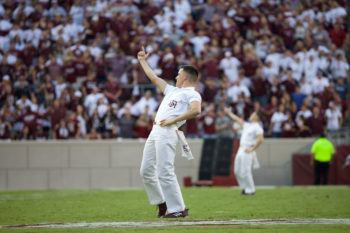
If there’s anyone who understands the power of the student body, it’s the Yell Leaders who stand before them.
“There is absolutely no feeling on this planet that can compare to standing before the 12th Man as a Yell Leader,” said Bob Segner, who was a Yell Leader for two years (1967-69), was a professor of construction science for 46 years, and is a founding member and the current president of The Association of Former Yell Leaders. “The energy of the 12th Man is absolutely palpable and is unlike anything else I have ever experienced.”
Segner had a message to current students: “Aggies of today, you should recognize that you are the 12th Man. And it is for you to preserve and carry forward this incomparable tradition.”
Texas A&M has rolled out its official line of 12th Man Centennial merchandise at 12thManShop.com.

